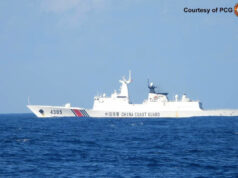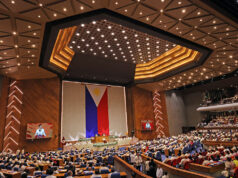Palace denies lawmaker’s claim of Chinese flag planted near Kota Island
By Ian Nicolas P. Cigaral
Reporter
MALACAÑANG on Thursday denied the claims of a lawmaker that a Chinese flag was planted on a sand cay near Philippine-controlled Kota Island in the disputed South China Sea, saying non-military vessels usually park in the sea feature.

Citing sources, Magdalo Party-List Rep. Gary C. Alejano early this week said a three-meter high Chinese flag mounted on a steel pipe was discovered planted on a sand cay located seven nautical miles northeast off Kota Island around the third week of July 2017.
Asked to confirm the lawmaker’s claims, Presidential Spokesperson Ernesto C. Abella said that based on a “very reliable source” that he declined, however, to identify, no flags had been raised in the area at the time indicated in Mr. Alejano’s statement.
Mr. Abella added that based on evidence and “unverified” reports given to him by his anonymous source, “many passers-through” frequent the cay to park their ships.
“These are citizens and not white or gray ships,” he said.
China claims most parts of the South China Sea, where trillion dollars’ worth of ship-borne goods pass through annually.
But the Asian power’s maritime ambitions were challenged by the Philippines, another claimant nation, in the Permanent Court of Arbitration (PCA) in The Hague that ruled in 2016 in Manila’s favor.
Taking office shortly before Manila’s legal victory against China, Philippine President Rodrigo R. Duterte has set aside PCA’s verdict, as the Philippines aims to tap billions of dollars in Chinese aid and investment, while berating traditional ally, the US.
Last week, Mr. Alejano released images of Chinese vessels, including fishing, coast guard, and navy ships that he said had been operating near the Philippine-occupied Pag-asa Island. A helicopter deployed by one of the Chinese naval vessels was also seen hovering over unoccupied sandbars, he said.
The solon’s report was later confirmed by US-based think tank Asia Maritime Transparency Initiative (AMTI) through satellite images. AMTI said China possibly wanted to “dissuade” Manila from its planned upgrades on Pag-asa.
Meanwhile, Supreme Court Senior Associate Justice Antonio T. Carpio, who was among those who argued in closed court hearings in The Hague, urged the government to “vigorously” protest Beijing’s “invasion of Philippine territory.”
But both Mr. Duterte and the Chinese government dismissed Mr. Carpio’s latest comments, with Beijing saying personalities harboring “ulterior motives” may be stirring up disputes with Manila through “irresponsible condemnation.”
“That is not true. China would not do that….He (Mr. Carpio) should go out there and find for himself,” the President, for his part, said.



